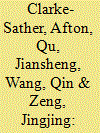|
|
|
Sort Order |
|
|
|
Items / Page
|
|
|
|
|
|
|
| Srl | Item |
| 1 |
ID:
109418


|
|
|
|
|
| Publication |
2011.
|
| Summary/Abstract |
This study asks whether sub-national inequalities in carbon dioxide (CO2) emissions mirror international patterns in carbon inequality using the case study of China. Several studies have examined global-level carbon inequality; however, such approaches have not been used on a sub-national scale. This study examines inter-provincial inequality in CO2 emissions within China using common measures of inequality (coefficient of variation, Gini Index, Theil Index) to analyze provincial-level data derived from the IPCC reference approach for the years 1997-2007. It decomposes CO2 emissions inequality into its inter-regional and intra-regional components. Patterns of per capita CO2 emissions inequality in China appear superficially similar to, though slightly lower than, per capita income inequality. However, decomposing these inequalities reveals different patterns. While inter-provincial income inequality is highly regional in character, inter-provincial CO2 emissions inequality is primarily intra-regional. While apparently similar, global patterns in CO2 emissions are not mirrored at the sub-national scale.
|
|
|
|
|
|
|
|
|
|
|
|
|
|
|
|
| 2 |
ID:
121349


|
|
|
|
|
| Publication |
2013.
|
| Summary/Abstract |
This study assessed household CO2 emissions (related to the consumption of necessary and luxury goods and services) of peasants and herdsmen households in arid-alpine regions in Gansu, Qinghai and Ningxia provinces, China. We also explored whether agriculture types, family income and family size have played any role in household CO2 emissions. In order to address these issues, we: (i) developed assessment indicators for household emissions; (ii) conducted semi-structured questionnaire household surveys; and (iii) employed input-output analysis (IOA). The results showed that, the average household CO2 emission per capita is 1.43 tons (t) CO2; the proportion of subsistence emissions (related to the consumption of necessary goods and services) accounts for 93.24%, whereas luxury emissions (generated due to consumption of specific goods and services that are consumed only when household income improves) only account for 6.76%t. Moreover, household CO2 emissions increase with family income and family size, but per capita emissions are inversely related to family size. The highest average household emissions were found in the alpine agricultural and pastoral region (6.18 t CO2), followed by the irrigated agricultural region (6.07 t CO2) and the rain-fed agricultural region (5.34 t CO2). In consideration of insignificant amount of household emissions from these poor and vulnerable groups of the society, this study suggests to follow the principle of fairness while making energy conservation, emission reduction and adaptation policies.
|
|
|
|
|
|
|
|
|
|
|
|
|
|
|
|
|
|
|
|
|